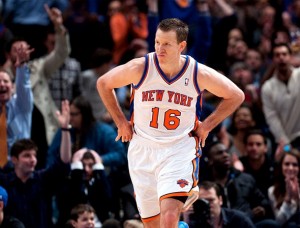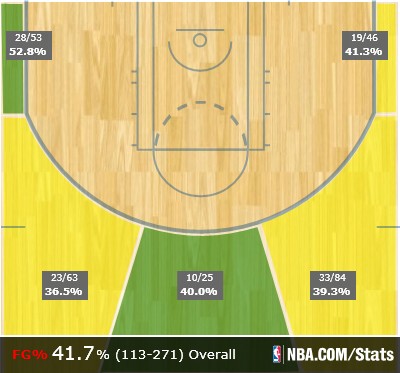 Call Steve Novak what you like, but there’s a correlation to be drawn between him and the New York Knicks winning.
Call Steve Novak what you like, but there’s a correlation to be drawn between him and the New York Knicks winning.
Doofy. Clumsy. Un-athletic. Slow. Whiter than snow. All of these are words or phrases often associated with Novak. What’s not often (enough) associated with the stretch forward, is his importance to the current Knicks team. Not just because he can hit threes, but because of what happens when he’s shooting in general.
We’re a year removed from the discount double-checks that became a daily staple at Madison Square Garden. Nights like those seem few and far between.
Novak is shooting 42 percent from beyond the arc, which is impressive, but nowhere near as astounding as the 47.2 percent clip he notched last season. Some have thus seen his four-year contract as a poor investment (it was a bit pricy), yet instead of shaking our heads and deeming Novak a diminishing cause, we should be asking: Why? Why isn’t Novak torching opposing defenses the way he did last season? Why does it seem that he’s caroming open shots off the rim more often? What gives?
Well, for starters, it comes down to how New York is using him. Novak is attempting 9.5 shots per 36 minutes compared to the 11.9 he hoisted up last season (7.7 to 10 in threes, respectively). Fewer shots makes it harder for him to get in a groove, to develop any sort of rhythm. Ask any player, at any level, and they’ll likely tell you the same thing.
For all the “struggles” he’s had on the offensive end, though, Novak still leaves his mark. Per Synergy Sports (subscription required) Novak is scoring 1.24 points per possession off spot-ups, putting him in the top 21 of that department. He’s also connecting on 44.3 percent of his spot-up threes, hardly an underwhelming mark.
The problem then, comes back to volume. New York needs to find more shots for Novak. Like now.
On the season, the Knicks are 26-7 when Novak attempts at least five shots. Not makes, but attempts. Given that 80.1 percent of his total shots come as spot-ups or off screens, him shooting is usually indicative of the Knicks moving the ball off screens, drive-and-kicks and the like. Their record when he hoists up at least five shots, though, is also a testament to how effective his sheer presence is.
When he’s on the floor, defenses aren’t able to swarm the ball (handler) as often. He’s got a fairly quick release, which makes it difficult for even the most deft of rotators to close out on him. As such, the opposition is forced to play more man-to-man defense, which favors iso-heavy scorers like Carmelo Anthony and J.R. Smith.
Supporting that assumption is how the Knicks are faring when any combination of those three are on the court. When Novak and Smith are together, New York is outscoring opponents by an average of 3.7 points per 100 possessions. When Novak’s with Anthony, that differential climbs to eight points. And when all three of them are playing at once, that margin holds strong at 5.7.
It’s not about Novak making shots. Not entirely. It’s about him being a threat to take them. The more he shoots, the more defenses have to respect him, the more one-on-one opportunities are created for others. It’s simple, really.
Of course, you want some of it to be about Novak hitting shots. New York is 19-5 when Novak hits on at least three of his attempts, 13-1 when he hits at least four, and a perfect 8-0 when he hits five or more.
The catch here is that the Knicks don’t want Novak attempting 20 shots per game (unless he’s on fire) to hit that mark. They want him to make a high percentage of them. Finding that balance between volume and efficiency can be difficult, hence his limited use.
Except limiting him, is only hurting his accuracy, and his ability to catch fire.
Novak has shot 40 percent or better from beyond the arc 30 times this season. In 22 of those three-point parades, he hoisted up a minimum of four threes.
Coincidence?
Perhaps, but let’s find out.
Novak has shot 50 percent or better from deep 23 times thus far. In 15 of those games, he’s gotten off at least four threes. He’s also shot 60 percent or better from behind the rainbow 12 times, eight of those contests seeing him release at least four deep balls.
You get the point.
The more Novak shoots, the more the Knicks win. And the more he shoots, the more he efficient he is. It’s a winning combination. Literally.
Those of the defensive persuasion will then sight him as a liability the Knicks just can’t cover up, but they’re only partially correct. Novak is allowing just 0.83 points per possession on that side of the ball (107th in the league), which is hardly anything to get excited about, but nothing to lose sleep over either.
To put it in perspective, Melo allows 0.9 points, almost a tenth of a point more than Novak. Playing time undoubtedly skews this, but putting Novak alongside a guy like Tyson Chandler, who’s flawless rotations help cover up Novak’s on-ball deficiencies, mitigates the significance of his struggles. In fact, the Knicks outscore opponents by an average of 7.8 points per 100 possession when Novak and Chandler are on the floor together, so that makes sense.
As does our suggestion that Novak needs more shots. Not because he makes them, but because of what it does for the Knicks when the threat for him to make them is alive and well.
And yeah, that “threat” tends to actualize itself the more he shoots.
Dan Favale is a firm believer in the three-pointer as well as the notion that defense doesn’t always win championships. His musings can be found at Bleacherreport.com in addition to TheHoopDoctors.com. Follow @danfavale on Twitter for his latest posts and all things NBA.



















